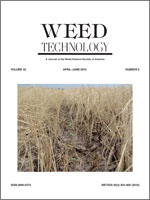Mesotrione provides PRE and early POST control of annual bluegrass during Kentucky bluegrass establishment from seed, but applications do not effectively control multitiller plants. The physiological effects of growth stage on efficacy and the basis of mesotrione selectivity between species is not well understood. The objectives of this research were to evaluate mesotrione behavior in these species at three growth stages: pretiller (3 to 5 leaves), 1-tiller, and multitiller (5 to 7 tillers). In greenhouse experiments, a single mesotrione application at 280 g ai ha−1 injured pretiller, 1-tiller, and multitiller annual bluegrass 54, 33, and 11% at 4 wk after initial treatment (WAIT), respectively. A sequential application of mesotrione increased injury to pretiller and 1-tiller annual bluegrass by 20 and 17% from a single treatment, respectively. Sequential mesotrione applications caused at least 14% injury to multitiller annual bluegrass and Kentucky bluegrass at all growth stages and did not reduce tillering compared to the nontreated. Annual bluegrass absorbed 34% more root-applied 14C-mesotrione than Kentucky bluegrass in hydroponic culture, but relative differences (Bq g−1) among growth stages were not detected for both species. Averaged across growth stages, annual and Kentucky bluegrass absorbed 31 and 35% of the applied radioactivity after foliar treatments, respectively. However, averaged across species, multitiller plants metabolized approximately two times more 14C-mesotrione than pretiller and 1-tiller plants. Overall, the selectivity of mesotrione for annual bluegrass control during Kentucky bluegrass establishment results from differential levels of root absorption. Mesotrione has limited efficacy for controlling multitiller annual bluegrass due to enhanced degradation compared to pretiller and 1-tiller plants.
Nomenclature Mesotrione; annual bluegrass, Poa annua L.; Kentucky bluegrass, Poa pratensis L. ‘Midnight'.
Mesotrione brinda control de Poa annua en PRE y POST temprano durante el establecimiento del césped Poa pratensis a partir de semilla, pero las aplicaciones no controlan efectivamente plantas en el estadio de múltiples hijuelos. Los efectos fisiológicos del estadio de desarrollo sobre la eficacia y las bases de la selectividad de mesotrione entre especies no se conocen bien. Los objetivos de esta investigación fueron evaluar el comportamiento de mesotrione en estas especies en tres estadios de desarrollo: pre-hijuelo (3 a 5 hojas), 1-hijuelo, y múltiples hijuelos (5 a 7 hijuelos). En experimentos de invernadero, una aplicación sencilla de mesotrione a 280 g ai ha−1 dañó P. annua en el estadio de pre-hijuelo, 1-hijuelo, y múltiples hijuelos 54%, 33, y 11% a 4 semanas después del tratamiento inicial (WAIT), respectivamente. Una aplicación secuencial de mesotrione aumentó el daño a P. annua en los estadios pre-hijuelo y 1-hijuelo en 20 y 17%, en comparación con el tratamiento sencillo, respectivamente. Las aplicaciones secuenciales de mesotrione causaron al menos 14% de daño a P. annua en el estadio de múltiples hijuelos y al césped P. pratensis en todos los estadios de desarrollo, y no redujo la producción de hijuelos al compararse con el testigo sin tratamiento. P. annua absorbió 34% más 14C-mesotrione aplicado a la raíz que P. pratensis en un cultivo hidropónico, pero diferencias relativas (Bq g−1) entre los estadios de desarrollo no fueron detect





